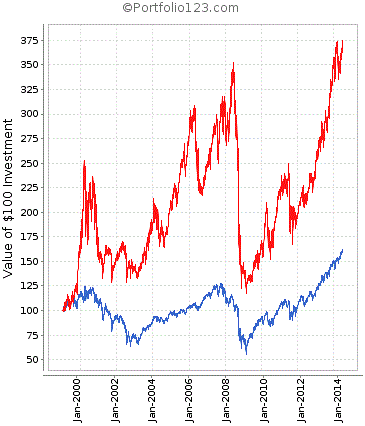Steve,
RE: The calculations do not make sense, could you elaborate more on your thoughts? The results are higher than I expected and taking 30 random stocks instead of using the decile performances is an unnecessary step that does not add value, but I was wondering what your thoughts were.
iavanti
First of all - the spread in CAGR for the momentum portfolios is too tight for 45 years of monthly rebalance. I would expect at least one losing simulation out of 1000. Maybe I don’t understand what he is doing?
Anyways, here is what I believe is an equivalent P123 simulation, except it is rebalanced every 4 weeks instead of monthly.
https://www.portfolio123.com/port_summary.jsp?portid=1209156
One run is shown below. Each run will be different due to the random selection of 30 stocks. I can’t believe I even spent time on this.
Steve

Steve, I got something similar to what you got. I don’t understand either. Although in the simulation alpha was added for the time period.
–Tom C
Tom - True, but the Alpha is negative (-4.5%) over last three years if you use Russell1000 w/Div as the benchmark.
Steve
I think I understand a little better now at least what he was trying to do.
If you are taking random diversified portfolios from the top decile for 45 years, I would think it would be likely to not expect a losing simulation out of any of them for the entire 45 year period. Any one year, sure, any ten years, yes, probably. But I could see it for a longer period like 45 years. Wherever the mean ended up for CAGR, I’d expect the distribution to look something like shown.
I am surprised at the spread however. O’Shaughnessy did an analysis of relative price strength in What Works On Wall Street from 1926-2009, and came to the conclusion that momentum was significant. One example was 6 month momentum. Decile 1 compound return was 14.11%, Decile 10 was 4.15%, All Stocks were 10.5%
Another was Large Stocks Universe, 12 month momentum, Decile 1 11.59%, Decile 10 6.29%, All Large Stocks, 9.69%
But the charts in the article have a much bigger dispersion than that from top decile to bottom.
–Tom C
Yes, that is true. If you run the same sim with selections from the lowest decile, you will get underperformance, but positive alpha over the last three years.
–Tom C
"Wherever the mean ended up for CAGR, I’d expect the distribution to look something like shown. "
Tom - I just ran multiple sims, perhaps 20 against the PRussell1000. The spread in annualized return is close to 5% over 14 years. It may be higher if I were to do 1000 sims. You should expect the spread in returns to be much higher than 5% over 50 years, probably ~20%. The spread isn’t going to converge, it will only get worse. Yet what I see is a spread of ~7% over 50 years.
The other thing is that he talks about riding the winners and cutting losses short (period). The test he performed had nothing to do with cutting losses short. The results would have been dramatically different (and probably a lot worse) if he had applied stops. It becomes death by 1000 paper cuts.
BTW In my sim I didn’t apply slippage or commissions. So the results would be a lot worse.
Something else that is rather odd is that he ran two sets of 50 years, the results for both sets - mean and range of results are almost identical. I’ve never seen results quite that consistent over two periods before.
Steve
Steve, so the spread might be a little larger, but there’s no way you’re going to have any one of your 1,000 samples be negative over a 45 year period (I assume that’s what you meant by “losing simulation”). He shouldn’t have said “cutting losses short”. He should have just said, keep investing in the highest momentum stocks, and drop the lowest momentum stocks. That’s my point. O’Shaughnessy’s work proves that is absolutely the case. And BTW one sample was 1927 to 1962 → 35 years, the other was 1963 to 2013 → 50 years
I am not convinced about whether or not the spread converges or diverges from a small dataset we have in the P123 database to a bigger one. As you noted before, we actually have negative alpha in the last three years. But that can happen easily.
–Tom C
Steve,
On a related note, I wondered if you had looked at any of Gray’s examples on value and modelled those in P123. I have not as of yet.
http://www.alphaarchitect.com/blog/2014/07/01/never-buy-expensive-stocks-period/#.U8syzfldWss
–Tom C
Tom - I haven’t tried his value examples. The results from the one pointed to in the momentum article looked reasonable.
I really hate the expression “Cut the losses short” as it doesn’t work in general, only if you have an extraordinary “spot on” momentum strategy (and Gray’s example isn’t). Also he isn’t in the highest momentum stocks because the most recent month is ignored. It doesn’t matter what the stock has done in the last month.
1927 to 1962 → 35 years (I was never much good at math ![]()
Take care
Steve
Very good article on value and momentum:
http://www.cxoadvisory.com/2091/value-premium/combining-value-and-momentum-across-asset-classes/
And Data from Fama and French, that I love to hate, since they still defend the EMH.
But their Data is a “gold mine”, very hard to research, but they have data about robust factors (back to the 1920s) that drive alpha (basically value and momentum factors and earnings growth factors).
http://mba.tuck.dartmouth.edu/pages/faculty/ken.french/data_library.html